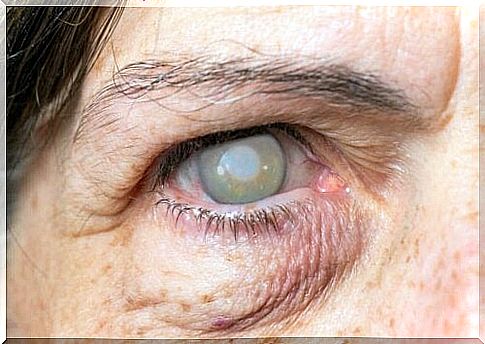Loss Of Vision: Causes And Symptoms

There is no doubt that sight is one of the senses we are most dependent on. Loss of vision therefore represents a serious problem that changes our lives dramatically. Do you want to discover the causes and symptoms of this problem? Read on, because we will explain it all!
First , at least one of the devices involved in vision must be affected before there is a reduction in vision. In that sense, partial or total blindness will occur when there is a problem with the cornea, retina or optic nerve.
Causes of partial loss of vision
When we talk about partial blindness, we are talking about those people who are still able to distinguish between certain shapes, lights and shadows, even though they have a significantly impaired vision. Therefore, there is still no complete loss of ability, but the individuals can no longer depend on their sight, as most individuals do.
Depending on the cause, this type of blindness can be either chronic or acute. Let us look at the most common causes of partial vision loss.

Damage to the cornea
Any damage to the surface of a tissue will create a scar and the cornea is no exception. This scar eliminates the transparency of the cornea, preventing light from reaching the retina. This produces a greater reduction in vision.
Damage to the cornea can have a variety of causes, ranging from severe infections to direct blows. Other stimuli that can damage the cells of the cornea to a significant depth will be able to create partial blindness.
The affected field of view will vary based on the location and size of the scar. In that sense , there is no specific presentation pattern. However, the following symptoms may occur:
- Blurred vision: Or an area of black or opaque vision.
- Pain: The affected eye itches.
- Eyes running in water.
- Red spots.
- Grainy feeling: The feeling of having something in the eye.
Cataracts
Another of the most common causes of partial blindness is cataracts. These are spots on the lens, which are the primary means of refracting light in the eye. This spot prevents light from reaching the retina properly, causing a loss of vision.
In most cases, it appears due to a deterioration of the lens or a lesion. According to various studies, cataracts represent the cause of 47.9% of cases of blindness in the elderly.
Among the primary symptoms reported by people with cataracts are blurred or spotted vision, faded colors and inability to see well at night. It can also be light that looks very clear or has a halo around it, as well as double vision.
Problems with the retina
The retina is the part of the eye that is responsible for transmitting light signals directed at the lens to the brain so that it can be processed. Any damage to it can thus create a loss of vision.
In most cases, defective capillaries cause problems with the retina. These defective capillaries filter fluid in the tissues. Among the most common reasons we can thus find the following:
- Diabetic retinopathy.
- Blockage of arteries or veins in the eye.
- A rupture of the retina.
- Partial detachment of the retina.
- Hypertensive retinopathy.
On the other hand, there is another type of lesion on the retina which is not related to the presence of fluid. An example of this is macular degeneration, where the center of the retina begins to deteriorate, creating blurred vision or a blind punk in the visual field.
As the latter , several infections by fungi, parasites or bacteria can seriously damage it. This is the case with ocular toxoplasmosis, which is very common in people with weakened immune systems.
Problems with the optic nerve
The optic nerve is responsible for transmitting all information captured by the retina to the brain. It is therefore also an important part of our body’s ability to see. Problems related to this structure usually affect one or more fields of view.
In most cases, they are produced by glaucoma. It is a common disease that creates an increased pressure in the eye that affects the nerve. In that sense, it is not able to transmit signals properly, which makes it difficult to see.
However, there are another number of disorders that can cause partial blindness that affect the optic nerve, such as the case of optic neuritis or inflammation of the nerve. In addition, indirect effects of cerebrovascular disease or tumors in the central nervous system can also affect vision.
It is important to note that the symptoms of optic nerve damage can vary depending on their etiology. However, people usually show a rapid loss of vision, reddish saturation in one or more fields of vision, double vision and pain in the eye.

Causes of total vision loss
On the other hand, some people also suffer from total blindness. It occurs when a person is unable to distinguish between light and dark. The situations that can cause total loss of vision can be the same ones that cause partial blindness. In this situation, however, they are in their final stage.
Strokes or serious injuries
When the blow is very severe and affects the entire cornea, the person may experience a complete loss of vision. One of the most common causes of this type of damage is chemical burns.
However, not all damage to the cornea is able to affect vision. An injury to the head or eyeball, whether it is penetrating or not, can damage the optic nerve and retina.
Complete detachment of the retina
We have mentioned partial detachment of the retina as a cause of partial blindness. If not treated in time, however, it can develop and become a total detachment, which would prevent any kind of visual impairment.
In most cases, it occurs due to fluid in the posterior part of the retina. This separates the tissue in the eyeball, which disrupts the supply of blood and it can cause ischemia and the area to die.
Although it may be asymptomatic and painless at first, some people may experience the following symptoms:
- The appearance of spots in the eye.
- Sudden light in all fields of view.
- Blurry vision.
- Sudden loss of peripheral vision and then central vision.
Proliferative diabetic retinopathy
Diabetic retinopathy is one of the complications of diabetes. It affects the capillaries in the retina, which filter fluid in the retina and promote the deposition of substances. In addition, it can block some healthy blood vessels.
In the initial stages of this disease, partial blindness may occur. However, if nothing is done to prevent it from developing, it causes a loss of vision.
This is because in the last stage, new blood vessels with very thin walls are created to try to supply the tissue properly with fluid. These new blood vessels are susceptible to rupture spontaneously and cause a hemorrhage in the retina.
Inflammation of the eye
A rare cause of vision loss is inflammation inside the eye. It should always be considered a medical emergency.
External microorganisms can penetrate the eye during an eye operation or injury and cause this infection. However, it can also be caused by an infection in the blood that has affected the eye.
Symptoms of people with this type of inflammation include severe pain in the eye with redness and the appearance of a yellow or white discharge in the eyeball. The eyelids also become inflamed.
Vascular occlusion can cause total loss of vision
All blood vessels in the body are susceptible to blockages. When blockages occur in blood vessels in the retina or optic nerve, the person experiences a painless loss of vision.
If the affected blood vessel is the central artery of the optic nerve, there will be insufficient supply of blood to the tissue. This will result in an inadequate supply of oxygen, which can cause it to swell and become permanently damaged.
When it hits the central vein in the retina, on the other hand, there will not be adequate drainage of blood. It will cause excessive accumulation of fluid in the tissue, which will lead to blindness.

When should one go to a doctor due to vision loss?
Loss of vision, whether partial or total, should always be seen as a medical emergency. In many cases, it can be painless and temporary. However, the pain does not indicate whether it is severe or not and therefore it should never be ignored.
For this reason , it is important to go to the doctor as soon as possible so that they can perform the necessary tests and make a correct diagnosis. Many of the causes have only a short period of time before the damage is irreparable.
It is important to state that when the loss of sight cannot be restored, a change in lifestyle is necessary. Today, fortunately, there are many ways in which people with impaired vision can perform their daily activities without any problems.









